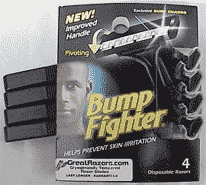You see? I told you before it happens most in African american men.
that is because you probably have strong curly hair.
And when shaving it, it penetrates the skin during regrowth.
So shaving will always(!) bring the same reaction…
You can put lotions on it everytime, but once shaving again, the problem will start again.
I am not trying to make you feel bad or overestimate the problem.
What I am trying to do is make you see this problem more realisticly to stop you from an endless search for a wonder cure, which in the end will end up in dissapointment.
It is very comfortable to deny the problem and believe in a wonder cure like a cream that will solve the problem, but my sincere opinion here is that you won’t find it.
Your condition is called “pseudofolliculitis barbae”, which mainly occurs in men from African-American decent.
Here; I got this from a dermatological website:
"
Pseudofolliculitis Barbae
Pseudofolliculitis barbae (razor bumps) is a common condition of the beard area occurring in up to 60% African American men and other people with curly hair. The problem results when highly curved hairs grow back into the skin causing inflammation and a foreign body reaction. Over time, this can cause keloidal scarring which looks like hard bumps of the beard area and neck. Shaving sharpens the ends of the hairs like a spear. The hairs then curve back into the skin causing pseudofolliculitis barbae.
A 100% effective treatment is to let the beard grow. Once the hairs get to be a certain length they will not grow back into the skin. For most cases, totally avoid shaving for 3 to 4 weeks until all lesions have subsided, while applying a mild prescription cortisone cream to the involved skin each morning. Shaving every other day, rather than daily, will improve pseudo-folliculitis barbae. If one must use a blade, water soften the beard first with a hot, wet washcloth for 5 minutes. A preshave solution (Hydroglyde from Moore skin care 1-800-745-9422) helps soften the hairs. Then use lubricating shaving gel (Edge, Aveeno), a prescription medicated shaving foam (Benzashave by Dermik) or British shaving oil and use the Aveeno PFB Bump Fighter Razor or the Flicker razor. Shave with the grain of the beard and do not stretch the skin. Use only one stroke over each area of the beard.
Use of an electric shaver may also help the condition because it does not cut as close as blades do. Use the electric razor on high setting to avoid close shaving and prepare beard with electric razor pre-shave. Do not stretch skin while shaving and shave with the grain of beard growth. Avoid multiple repetitions of strokes in the same area. Do not press razor head hard against the skin. Shave every other day. Better still is a barber's clipper (with clipping guard) to prevent shaving closer than 1mm cut of whisker hair.
Some doctors recommend chemical "shaving" with products such as Magic Shave, Surgex shaving powder, Nair or Neet (these are brands of Barium sulfide or Calcium thioglycolate depilatories - very mild to strong). These dissolve the hairs but can cause chemical burns on facial skin. It should be left on for less time than the package recommends until one sees how the skin reacts to it.
Most patients "cannot tolerate" these because they don't wait for their skin to clear before using them as directed. PFB involved skin is not "normal," and it should be expected to be more easily irritated than normal skin. These depilatories should be tried only once the skin is bump free. Use only every 48-72 hours. Use mildest form that works. Apply to small areas at a time (1/4 - 1/2 of the face) and start removal no later than 3 minutes (for Barium sulfide types) or 5 minutes (for calcium thioglycolate types) after application. Remove with spatula, butter knife, tongue blade, or other blunt straight edge. Use short, rapid strokes against the direction of hair growth. Keep shaving instrument moist but wiped clean. If some hairs remain, repeat after 30-60 seconds. Wait if within 3 minutes of original application. Rapid and thorough rinsing should be done two or three times with soap and water. Neutralize depilatory with a diluted vinegar solution (1 tablespoon per pint of water) then rinse again thoroughly with tap water.
Electrolysis and laser hair removal should be considered when all else fails, but these are expensive and take repeated visits. There is a very small risk of scarring. A few insurance companies will cover some or all of the cost.
Medications are also prescribed to speed healing of the skin. Glycolic acid lotion 8% is effective (Alpha-hydrox, Neo-Strata, others). Prescription antibiotic gels (Benzamycin, Cleocin-T) or oral antibiotics are also used. Retin-A is a potent treatment that helps even out any scarring after a few months. It is added as a nightly application of Retin-A Cream 0.05 - 0.1% to the beard skin while beard is growing out. Use as tolerated, as it is somewhat irritating.
This describes the treatment options. The individual prescription can be developed specifically by a dermatologist and may differ somewhat from those described here. "
My gues is: Go for permanent hair removal.
Good luck.



 Unles you went to a compounding pharmacy and convinced a nice druggist to mix you up a batch, but if you are going to do that, you may as well include the glycerine and or poly-glycols as well.
Unles you went to a compounding pharmacy and convinced a nice druggist to mix you up a batch, but if you are going to do that, you may as well include the glycerine and or poly-glycols as well.